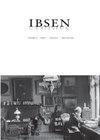How Ibsen Fared in Russian Culture and Politics
IF 0.1
0 THEATER
引用次数: 1
Abstract
Flying into Moscow from the West in the Soviet era, one could see the city ringed round by a green belt. This was the Khimki Forest, an immemorial woodland of old-growth birch trees that harbored a dense ecology of flora and fauna. Nowadays the passenger sees the forest pocked by the roofs of Mcmansions, built by oligarchs in defiance of zoning laws or natural topography. What’s worse, a highway to St Petersburg has been projected, evoking mass protest on environmental grounds. The project was suspended in 2010, but not before Mikhail Beketov, a crusading investigative reporter, was severely beaten, losing one leg and four fingers as a result. Beketov died in Khimki on 8 April 2013 of cardiac arrest, a belated result of the attack. Three weeks later, the first Russian production of An Enemy of the People in over a century opened at the Mayakovsky Theatre in Moscow. The poster displayed a Victorian gentleman in a morning coat and top hat, wearing a gas mask. It signaled that the production would be a provocation. The title itself was a challenge. Konstantin Stanislavsky’s production of 1901 had been called, less provocatively, Doctor Stockmann. “Enemy of the people” (vrag naroda), originally a Jacobin term of abuse, was revived by Lenin in 1917 to tar the Constitutional Democratic Party. The aspersion was cast far and wide by Stalin during the agrarian collectivization movement of the early 1930s to attack “kulaks,” recalcitrant peasants, and again during the purges of 1937. The accused were made to denounce themselves and others as enemies of the people, an accusation constantly repeated in the charge sheets. In a Russian context, it is heavily freightedwith sinister connotations. Ibsen Studies, 2014 Vol. 14, No. 2, 91–108, http://dx.doi.org/10.1080/15021866.2014.998046易卜生在俄国文化和政治中的表现
在苏联时代,从西方飞进莫斯科,可以看到这座城市被绿化带环绕着。这就是希姆基森林,这是一片古老的桦树林地,拥有密集的动植物生态。如今,乘客看到的是寡头们无视分区法或自然地形而建造的高楼大厦,它们的屋顶把森林挤得稀里稀气。更糟糕的是,一条通往圣彼得堡的高速公路已经计划好了,这引发了以环境为由的大规模抗议。该项目于2010年被暂停,但在此之前,调查记者米哈伊尔·别克托夫(Mikhail Beketov)遭到严重殴打,失去了一条腿和四根手指。别克托夫于2013年4月8日在希姆基死于心脏骤停,这是袭击造成的迟来的结果。三周后,俄罗斯一个多世纪以来的第一部《人民公敌》在莫斯科的马雅可夫斯基剧院上演。海报上是一位维多利亚时代的绅士,穿着晨衣,戴着大礼帽,戴着防毒面具。它暗示,这部影片将是一种挑衅。这个头衔本身就是一个挑战。康斯坦丁·斯坦尼斯拉夫斯基1901年的作品被称为“斯托克曼博士”。“人民公敌”(vrag naroda)一词最初是雅各宾派的蔑称,1917年被列宁用来指立宪民主党。在20世纪30年代早期的农业集体化运动期间,斯大林对“富农”(顽固的农民)进行了广泛的攻击,在1937年的大清洗期间再次使用了这种诽谤。被告被要求谴责自己和他人是人民的敌人,这一指控在起诉书中不断重复。在俄罗斯语境中,这个词充满了邪恶的含义。易卜生研究,2014年第14卷第2期,91-108,http://dx.doi.org/10.1080/15021866.2014.998046
本文章由计算机程序翻译,如有差异,请以英文原文为准。
求助全文
约1分钟内获得全文
求助全文

 求助内容:
求助内容: 应助结果提醒方式:
应助结果提醒方式:


